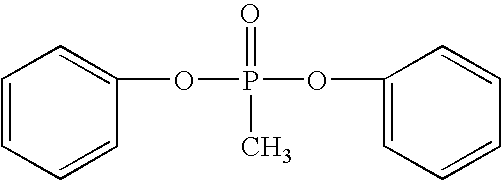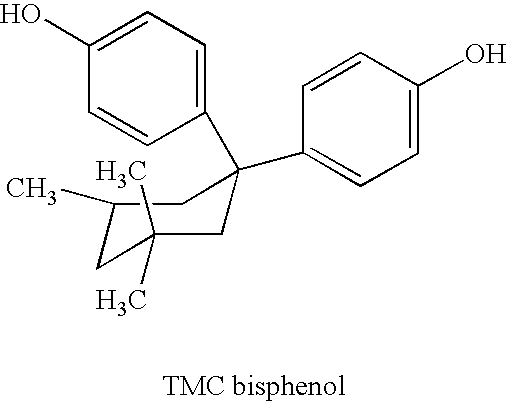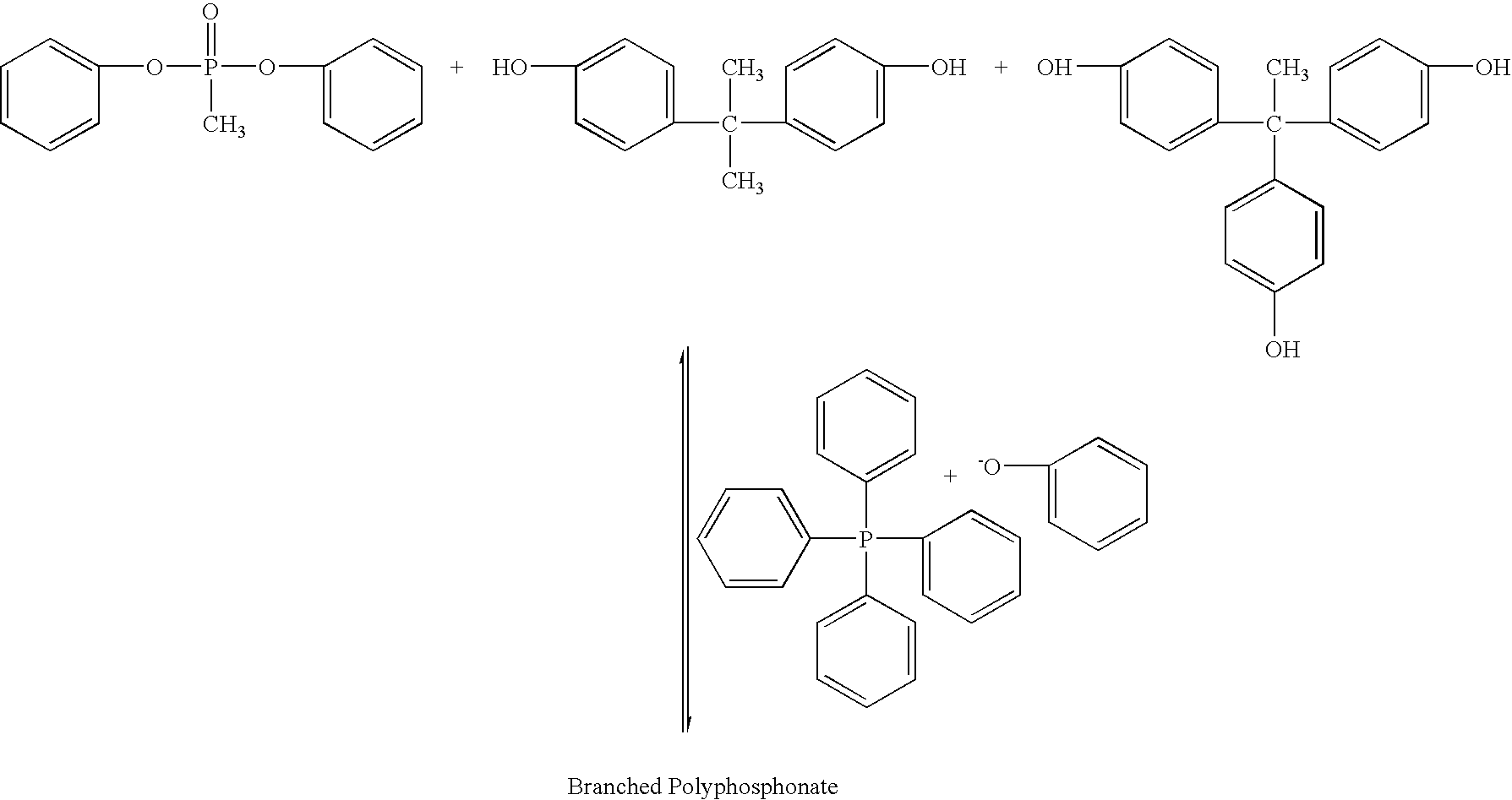Branched polyphosphonates that exhibit an advantageous combination of properties, and methods related thereto
a polyphosphonate and branched technology, applied in the field of branched polyphosphonates, can solve the problems of reduced molecular weight and reactive end groups, limited success, and stoichiometric imbalance, and achieve the effects of poor processing characteristics, poor solubility, and high melt viscosity
- Summary
- Abstract
- Description
- Claims
- Application Information
AI Technical Summary
Benefits of technology
Problems solved by technology
Method used
Image
Examples
example 1
Synthesis of a Branched Polyphosphonate
A 250 mL, three neck round bottom flask equipped with a mechanical stirrer, distillation column (10 cm) filled with hollow glass cylinders, condenser, and vacuum adapter with control valve was flushed with nitrogen for 0.5 hour. Methyldiphenoxy-phosphine oxide (38.66 g)—because this compound is 95.9% pure as determined by high performance liquid chromatography (HPLC)—the precise amount of this compound is actually (37.07 g, 0.1493 moles), 2,2-bis(4-hydroxyphenyl)propane (bisphenol A), (33.28 g, 0.1458 moles), tetraphenylphosphonium phenolate (0.012 g, 2.77×10−5 moles, 0.00019 mole per one mole of bisphenol) and 1,1,1-tris(4-hydroxyphenyl)ethane (0.459 g, 0.0015 mole, 0.0103 mole per mole of bisphenol) were placed into the flask and the flask was flushed with nitrogen again. (This is an excess of 2.4 mole percent of methyldiphenoxyphosphine oxide relative to the molar amount of bisphenol). The distillation column was wrapped with heating tape an...
example 2
Synthesis of a Branched Polyphosphonate
A 250 mL, three neck round bottom flask equipped with a mechanical stirrer, distillation column (10 cm) filled with hollow glass cylinders, condenser, and vacuum adapter with control valve was flushed with nitrogen for 0.5 hour.
Methyldiphenoxyphosphine oxide (38.66 g)—because this compound is 95.9% pure as determined by HPLC—the precise amount of this compound is actually (37.07 g, 0.1493 moles), 2,2-bis(4-hydroxyphenyl)propane (bisphenol A), (33.28 g, 0.1457 moles), tetraphenylphosphonium phenolate (0.012 g, 2.77×10−5 moles, 0.00019 mole per one mole of bisphenol) and 1,1,1-tris(4-hydroxyphenyl)ethane (0.459 g, 0.0015 mole, 0.0103 moles per mole of bisphenol) were placed into the flask and the flask was flushed with nitrogen again. (This is an excess of 2.4 mole percent of methyldiphenoxyphosphine oxide relative to the molar amount of bisphenol). The distillation column was wrapped with heating tape and heated. The reaction vessel was placed i...
example 3
State-of-the-Art Comparative Example (Branched Polyphosphonate)
A branched polyphosphonate was prepared following information contained in U.S. Pat. Nos. 4,331,614 and 4,415,719 for comparison with the branched polyphosphonates of the present invention. The molar excess of 2,2-bis(4-hydroxyphenyl)propane (bisphenol A), (33.28 g, 0.1457 moles) to the phosphonic diester (37.07 g, 0.1493 mole) was 2.4 mole %. The amount of sodium phenolate used (0.006 g, 5.16×10−5 moles) was 3.54×10−4 moles relative to one mole of bisphenol, and (0.459 g, 1.5×10−3 moles) of 1,1,1-tris(4-hydroxyphenyl)ethane (i.e., branching agent) was used. The reaction, conducted under conditions similar to those described for Examples 1 and 2, yielded a relatively viscous melt. The polymer was isolated and it exhibited some toughness, but not as tough as the polymers described in Examples 1 and 2. A 0.5% solution of the polymer in methylene chloride exhibited a relative viscosity of about 1.09 at 23° C. A film was cas...
PUM
| Property | Measurement | Unit |
|---|---|---|
| Tg | aaaaa | aaaaa |
| Tg | aaaaa | aaaaa |
| Tg | aaaaa | aaaaa |
Abstract
Description
Claims
Application Information
 Login to View More
Login to View More - R&D
- Intellectual Property
- Life Sciences
- Materials
- Tech Scout
- Unparalleled Data Quality
- Higher Quality Content
- 60% Fewer Hallucinations
Browse by: Latest US Patents, China's latest patents, Technical Efficacy Thesaurus, Application Domain, Technology Topic, Popular Technical Reports.
© 2025 PatSnap. All rights reserved.Legal|Privacy policy|Modern Slavery Act Transparency Statement|Sitemap|About US| Contact US: help@patsnap.com



